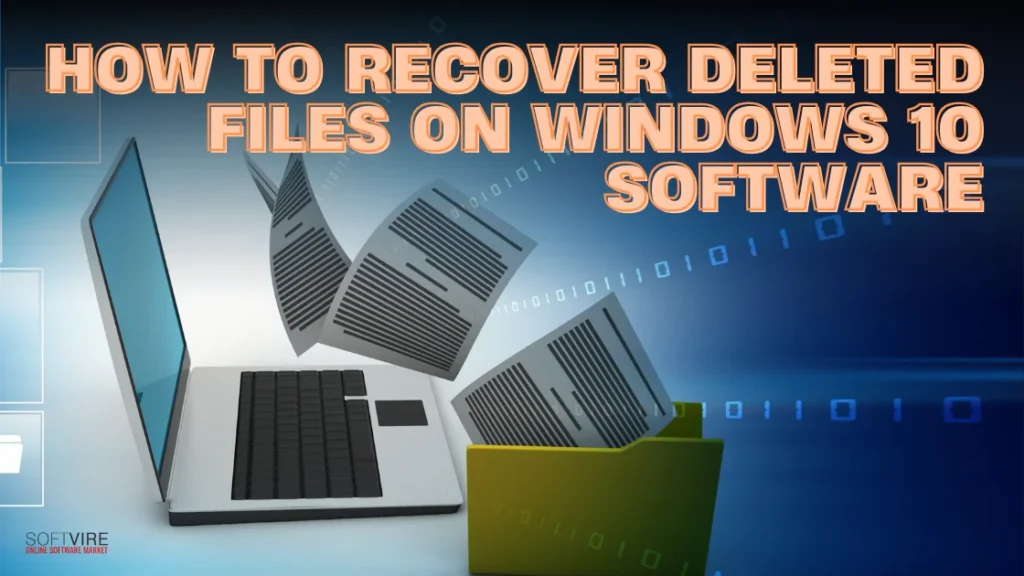Everyone has experienced the fear of discovering they have deleted a file they didn’t want to. Whether it’s a professional spreadsheet, a Word document, or a priceless snapshot, unintentionally erasing data may be upsetting. The good news? If you are running Windows 10 software, you can likely recover those data.
Thanks to built-in features and reliable Windows 10 software, there are multiple methods to recover deleted files—even after they’ve been removed from the Recycle Bin. This guide walks you through the step-by-step process, offering both free and paid options to get your data back safely.
Try the Recycle Bin first.
The Recycle Bin is a secret system folder for which Windows allows a tiny fraction of your hard drive space. This section ensures that deleted files are not erased but saved for later use. Files are usually recoverable after deletion or after the Bin is empty, so long as you don’t do any of those things permanently.
Click the Recycle Bin icon to use it. Like any other folder, you can sort files by name, location, date, and more. Files can also be named and found that way. Right-click and choose “Restore.” to recover the file.
Althouh tougher, a file may be recovered after being permanently deleted (Shift+Del) or emptying the Recycle Bin. Success depends largely on how rapidly you respond to its help.
Deleted files do not remove their data. Instead, the operating system frees up space to add new data to the file’s groups.
Microsoft’s Windows File Recovery
Microsoft offers a free Windows 10 software and 11 command-line application that searches for deleted files and attempts to restore them. The solution, Windows File Recovery, is compatible with solid-state drives (SSDs), memory cards, USB devices, and mechanical hard drives. It also provides both standard and extended modes to bring a file back to life.
Third-party recovery utilities
In general, we have been successful with the use of several third-party recovery solutions. One more time, the success of these programs greatly depends on how fast you try to recover a file after it has been destroyed. However, such programs will assist you in reviving the file, provided it is still wholly or mainly intact.
Free and commercial versions of a wide range of programs are both accessible. Consider trying a couple of these free tools:
- Recuva: Both free and premium versions of Recuva can recover data through hard drives, USB sticks, and memory cards. It also comes in a portable USB stick version that doesn’t write new data to your hard drive.
- Glarysoft File Recovery Free is another data recovery option, and it has both free and premium versions.
- Disk Drill: Clean interface, good recovery success rate.
- Stellar Data Recovery: More advanced options for deep scanning and file previews.
Several recovery tools are available in the Microsoft Store. Windows File Recovery already has a graphical user interface (GUI), but one free program adds one. Microsoft really ought to have included it.
Find deleted files through the File History feature.
This built-in feature of Windows automatically backs up data from your personal computer’s Desktop, Favorites, and Libraries.
- To open this program, click the Start button and select “Control Panel” in the search bar.
- Proceed to the System and Security menu, choose File History, and select the option to Restore personal data.
- When you have located the file you are looking for, use the green button at the bottom of the page to restore it.
For this procedure to be successful, a backup copy must be stored in a particular area.
Recover erased files in Windows using the Undo Delete feature.
This approach is practical when a file has been deleted since it enables you to rapidly undelete it by typing a command on the keyboard.
When you delete the file, be sure that you do not leave the window or folder open. At the same time, hit the CTRL key and the Z key on your keyboard. You may restore the correct file by repeatedly pressing the CTRL and Z keys. It is possible if you have already performed other operations. You also have the option to right-click the folder’s interface and choose Undo Delete from the menu that appears.
Any previous activities will be lost if you exit the interface or restart your computer.
Use the Restore Previous Versions Feature
Windows 10 software has a data recovery option that is quite helpful. This feature is called “Restore previous versions,” it enables you to restore earlier versions of all of the files and folders on your computer, assuming you have enabled it. That is to say:
- Launch Windows.
- Launch the search bar and type “system protection” before pressing Enter.
- Select a disc drive, then hit “Configure” in the “Protection Settings” menu.
- After making the selection, click “OK” to activate system protection.
- Now, you can “Restore previous versions” to restore an earlier version of a file. To do so, right-click on the file and go to the “Previous Versions” menu.
- Return a folder or file to its original condition.
Few Tips to Improve Recovery Success
Restoring deleted files is not always possible, but observing these guidelines can lead to success:
- Act Quickly: The longer you wait, the more likely your deleted file’s space will be overwritten. When you realize the file is missing, stop using that drive.
- Don’t Install Recovery Software on the Same Drive: If your file was on Drive C, don’t install recovery software on Drive C. Use an external USB or another partition.
- Use Deep Scan When Needed: Quick scans may not find deeply buried files. Deep scans take longer but usually yield better results.
- Save Recovered Files Elsewhere: Always restore recovered files to a different drive to avoid corruption or overwriting during the process.
- Regularly Backup Your Files: Prevention is better than recovery. Set up File History, OneDrive, Google Drive, or an external backup to avoid future heartache.
Final Thoughts
Losing a file doesn’t always mean it’s gone forever. Windows 10 software gives you several ways to recover deleted files, whether through the Recycle Bin, built-in backups, or powerful recovery tools. The key is to act quickly and follow the right steps.
Consider setting up a regular backup routine if you work with important files daily—documents, photos, creative projects, or spreadsheets. Tools like File History, OneDrive, or even an external hard drive can help the next time something goes wrong.
If all else fails, don’t panic. With the right tools and patience, you can still have a decent shot at getting your files back. So without further ado, get your own Windows 10 software now at the Softvire Global Market and try to recover your deleted files yourself.



